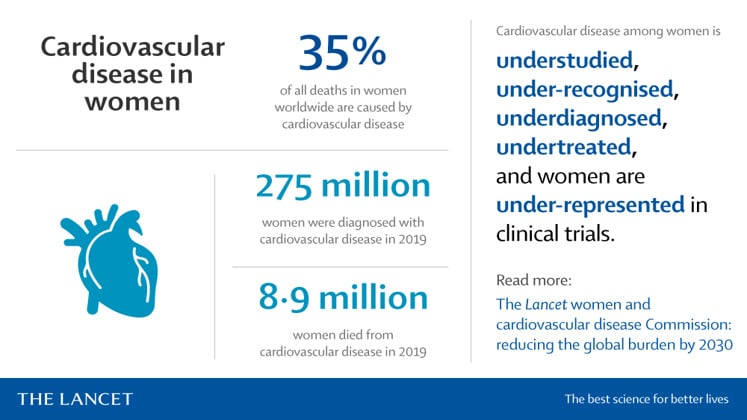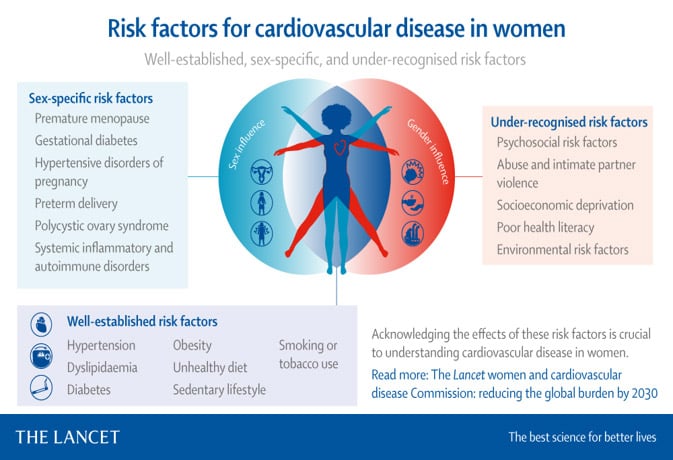The Lancet Commission to reduce global burden of cardiovascular disease in women by 2030
Reported from the European Society of Cardiology ESC Congress 2021
Cardiovascular disease (CVD) is the leading cause of death for women globally!
In 2019, there were approximately 275 million women around the world with CVD, with global age-standardised prevalence estimated at 6,402 cases per 100,000. Ischaemic heart disease was the leading cause of death from CVD worldwide in 2019 accounting for 47% of CVD deaths, followed by stroke (36% of CVD deaths).
Globally there are considerable geographical differences in CVD prevalence. Egypt, Iran, Iraq, Libya, Morocco, and United Arab Emirates had the highest age-standardised prevalence of CVD. Bolivia, Peru, Colombia, Ecuador, and Venezuela had the lowest prevalence. Although globally the prevalence of CVD in women has been declining (4.3% decrease since 1990), some of the world’s most populous nations including China (10% increase), Indonesia (7%), and India (3%) have seen an increase in CVD!
Despite these stark statistics:
- Awareness that heart disease is the leading cause of death among women declined from 2009 to 2019.
- In socially deprived regions women have higher mortality than men.
- Women are especially affected by the association of low socioeconomic status and cardiovascular risk.
- There is an increase in myocardial infarction in young women.
- Women are less likely to receive guideline recommended treatment.
- Women have higher mortality after MI and PCI.
- High blood pressure is the greatest risk factor contributing to years of lost life from CVD in women, followed by high body mass index and high LDL cholesterol.
- Many CVD risk factors in women are still under-recognised.
- Evidence on female-specific CVD risk factors (pregnancy disorders, menopause, and gynaecological conditions) is increasing (1).
- The COVID-19 pandemic has shown how the socioeconomic status and the cultural role of the woman in society affect the physical and mental health and wellbeing of women globally (2).
- Women are still underrepresented in cardiovascular clinical trials (3).
The first-ever global report on cardiovascular disease in women
To address these inequalities, in the first-ever global report on cardiovascular disease in women, researchers call for urgent action to improve care and prevention, fill knowledge gaps, and increase awareness to tackle the worldwide leading cause of death among women.
The all-female led Commission report was published in The Lancet (4) and presented during a late breaking session at the ESC Congress Digital Experience 2021. The Commission authored by 17 leading experts from 11 countries from all continents of the world aims to help reduce the global burden of cardiovascular conditions including heart disease and stroke that account for 35% of deaths in women worldwide by 2030.

Source: The Lancet - Key figures on cardiovascular disease in women
The aims of the commission are as follows:
- To reduce the global burden of cardiovascular disease in women by 2030
- To promote cardiovascular health and improve outcomes for women worldwide
- Identify existing evidence and gaps in cardiovascular research, treatment, access to care and prevention in women.
- Ignite global awareness of sex- and gender-specific disparities in CVD and provide a springboard for future research.

Source: The Lancet - Risk factors for cardiovascular disease in women
10 recommendations to tackle inequities
The commissioners have outlined 10 ambitious recommendations to tackle inequities in diagnosis, treatment, and prevention to reduce CVD in women as follows:
- Direct funding for real time and accurate data collection on prevalence and outcomes of CVD in women globally
- Develop educational programs on CVD in women for physicians, scientists, allied healthcare providers and communities
- Prioritise sex-specific research focused on identifying the pathophysiology and natural history of CVD
- Develop strategies to improve enrolment and retention of women in cardiovascular trials
- Prioritise funding in global health organizations for CVD health programs in women from socioeconomically deprived regions
- Educate healthcare providers and patients regarding early detection and prevention of CVD in young women
- Establish policy-based initiatives and medical and community outreach CVD risk factor programs in settings frequented by women
- Research is needed to identify the impact of sex-specific psychosocial and socioeconomic risk factors on CVD in women and evaluate intervention strategies
- Scale up healthy heart programs in highly populated and under industrialized regions
- Embrace public-private partnerships to develop broad scale programs to save lives of women with CVD
What can the interventional community do to help reduce the global burden of heart disease in women?
Appropriate diagnosis and management of women specific conditions targeting ischaemic heart disease.
- Ischaemia with non-obstructive coronary arteries (INOCA): Undertake research on the epidemiology, investigate underlying mechanisms, and define evaluation and treatment (5)
- Myocardial Infarction with non-obstructive coronary arteries (MINOCA): Women presenting with MI are more than twice as likely as men to have MINOCA. Understand the underlying mechanisms to provide therapeutic options. Investigate treatment options and secondary prevention strategies
- Spontaneous coronary artery dissection (SCAD): Address uncertainties in prevalence and treatment as well as post-SCAD lifestyle modifications and medical therapies
- ST elevation myocardial infarction (STEMI): Target underestimation of cardiovascular risk in women. Continue efforts to provide guideline-recommended treatment to women with STEMI. Investigate potential biological sex differences as underlying reasons for the sex-related mortality gap in STEMI
- Non ST elevation acute coronary syndrome (NSTEACS): The optimal invasive strategy for women presenting with NSTEACS is unknown. Adequately powered RCTs to identify potential sex differences in treatment strategies in patients presenting with NSTEACS is needed (6)
- Research: Adopting more inclusive enrolment criteria, and educating recruitment staff on the importance of involving women in trials
In summary, CVD affects 50% of the world’s population (women). Despite significant progress in cardiovascular care over the past several decades, in 2021, CVD remains the leading cause of morbidity and mortality for women! The COVID 19 pandemic seems to have amplified some of the many disparities that exists in our population.

Source: The Lancet - Global cardiovascular disease burden in women
Let us all come together to address the cardiovascular disease in women, a major global health problem by utilising the opportunities to deliver comprehensive care and intervene for women’s cardiovascular health!
Now is the time to act and intervene! Let’s do this!!
References
1. Cardiovascular health after menopause transition, pregnancy disorders, and other gynaecologic conditions: a consensus document from European cardiologists, gynaecologists, and endocrinologists. Maas AHEM, Rosano G, Cifkova R, Chieffo A, van Dijken D, Hamoda H, Kunadian V, Laan E, Lambrinoudaki I, Maclaran K, Panay N, Stevenson JC, van Trotsenburg M, Collins P.Eur Heart J. 2021 Mar 7;42(10):967-984
2. Socioeconomic status and cardiovascular health in the COVID-19 pandemic. Naylor-Wardle J, Rowland B, Kunadian V.Heart. 2021 Mar;107(5):358-365
3. The importance of achieving sex- and gender-based equity in clinical trials: a call to action. van Diemen J, Verdonk P, Chieffo A, Regar E, Mauri F, Kunadian V, Sharma G, Mehran R, Appelman Y.Eur Heart J. 2021 Aug 5;42(31):2990-4.
4. The Lancet women and cardiovascular disease Commission: reducing the global burden by 2030. Vogel B, Acevedo M, Appelman Y, Bairey Merz CN, Chieffo A, Figtree GA, Guerrero M, Kunadian V, Lam CSP, Maas AHEM, Mihailidou AS, Olszanecka A, Poole JE, Saldarriaga C, Saw J, Zühlke L, Mehran R.Lancet. 2021 Jun 19;397(10292):2385-2438
5. An EAPCI Expert Consensus Document on Ischaemia with Non-Obstructive Coronary Arteries in Collaboration with European Society of Cardiology Working Group on Coronary Pathophysiology & Microcirculation Endorsed by Coronary Vasomotor Disorders International Study Group. Kunadian V, Chieffo A, Camici PG, Berry C, Escaned J, Maas AHEM, Prescott E, Karam N, Appelman Y, Fraccaro C, Louise Buchanan G, Manzo-Silberman S, Al-Lamee R, Regar E, Lansky A, Abbott JD, Badimon L, Duncker DJ, Mehran R, Capodanno D, Baumbach A.Eur Heart J. 2020 Oct 1;41(37):3504-3520
6. 2020 ESC Guidelines for the management of acute coronary syndromes in patients presenting without persistent ST-segment elevation. Collet JP, Thiele H, Barbato E, Barthélémy O, Bauersachs J, Bhatt DL, Dendale P, Dorobantu M, Edvardsen T, Folliguet T, Gale CP, Gilard M, Jobs A, Jüni P, Lambrinou E, Lewis BS, Mehilli J, Meliga E, Merkely B, Mueller C, Roffi M, Rutten FH, Sibbing D, Siontis GCM; ESC Scientific Document Group.Eur Heart J. 2021 Apr 7;42(14):1289-1367




No comments yet!